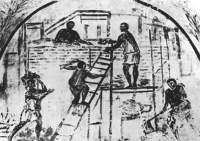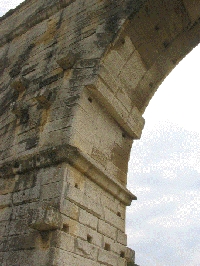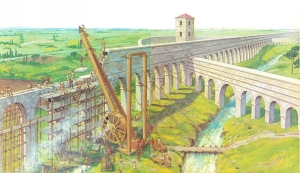Construction Tools
The stone pictured above (CIL X.868) bears the name of Diogenes Structor (Diogenes, the mason), The tufa plaque was originally situated high up on the garden wall on the north-west corner in
Vicolo del Gigante in Pompeii. So Diogenes was a proud mason who inscribed his name here and / or an original tombstone was reused. It 'reads' als follows:
- a plump line
- a trowel
- an apotropaic phallus (to prevent evil)
- a levelling square
- a stone-mason's hammer
- a chissel
and possibly an amphora and a platerer's tool.
From: J.P. Adam La construction Romaine, materiaux et techniques (1989) / Roman building, materials and techniques (1992) pag 42
Scaffolding
 |
The best example of a view on scaffolding in ancient times is undoubtedly the painting recovered from the tomb of Trebius Justus at the start of the via Latina in Rome. This extremely interesting document,
occupying the tympanum of a vault, shows five men working on the construction of a brick building. On the ground and on the right [ .. ] a man with a hoe is busy mixing mortar
that he is then going to put into a trough placed beside him on a stand. Two workmen are carrying material on their shoulders; the first, on the ground, has bricks in a basket,
the second, on a ladder, a trough of mortar. Finally, on the scaffolding, whose standards and ledgers, windbraces and boards are distinguishable, two masons on either side of
the wall (only the scaffolding poles sticking above the building can be seen of the scaffolding on the other side) are laying the bricks and covering them with mortar with their trowels.
To economise on wood, while still guaranteeing complete stability to the arrangement, the Roman builders frequently used socketed scaffolding, which replaced the support of
the poles with the masonry itself. As they progressed up the wall, the workmen carefully made a series of holes covered by a small lintel, aligned at the same horizontal level
and in which they placed the ends of the putlogs. If there was a row of scaffolding poles to ensure the support of the outer end of the putlogs, they could be put in place straight
away, a technique still in use today in traditional Italian masonry; but to do away with the poles completely, a certain height of masonry had to cover the supporting level in
order cantilever scaffolding, the putlogs could go straight through the wall and support the floor symmetrically on either side. To increase rigidity and solidity, the putlogs of
cantilever scaffolding had to be supported on the facing by a vertical scaffolding pole and a diagonal brace.
From: J.P. Adam: pag 151 -153)
|


